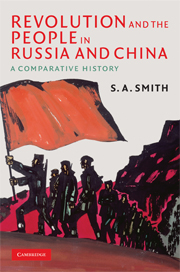Book contents
- Frontmatter
- Contents
- Acknowledgments
- Introduction: Capitalist Modernity and Communist Revolution
- 1 Memories of Home: Native-place Identity in the City
- 2 The Awakening Self: Individuality and Class Consciousness
- 3 After Patriarchy: Gender Identities in the City
- 4 Saving the Nation: National and Class Identities in the City
- 5 Workers and Communist Revolution
- Index
- References
5 - Workers and Communist Revolution
Published online by Cambridge University Press: 05 June 2012
- Frontmatter
- Contents
- Acknowledgments
- Introduction: Capitalist Modernity and Communist Revolution
- 1 Memories of Home: Native-place Identity in the City
- 2 The Awakening Self: Individuality and Class Consciousness
- 3 After Patriarchy: Gender Identities in the City
- 4 Saving the Nation: National and Class Identities in the City
- 5 Workers and Communist Revolution
- Index
- References
Summary
Revolutions in the Chinese phrase ‘turn heaven and earth upside down’ (tianfan difu). They are moments of rupture that release fresh energies and set in train all manner of new developments. Yet the course of revolutionary regimes is also powerfully constrained by the legacies of the past. In the preceding four chapters it has been argued that in the decades leading up to the Communist revolutions in Russia and China, the onset of capitalist modernity led to migrants undergoing complex transformations of social identities as they mutated into urban workers, some of which proved compatible with the Communist project, others of which did not. The purpose of this chapter is to explore some of the positive and negative relationships between these pre-revolutionary transformations of social identity and the subsequent evolution of Communist regimes (looking, chronologically, at the period up to 1941, the onset of the Second World War, in the case of the Soviet Union, and up to 1976, the end of the Mao era, in the case of the PRC). It is not intended to provide a comprehensive discussion of the fate of workers under Communism, still less a synoptic account of the development of Communist societies; nor is it intended to suggest that pre-revolutionary transformations in workers' social identities were a major factor determining the course of post-revolutionary regimes.
- Type
- Chapter
- Information
- Revolution and the People in Russia and ChinaA Comparative History, pp. 192 - 235Publisher: Cambridge University PressPrint publication year: 2008



